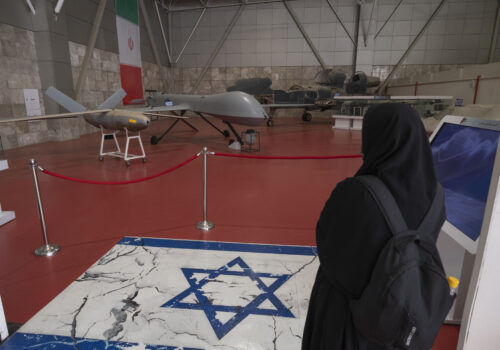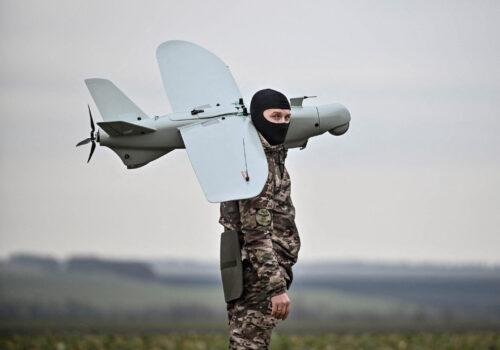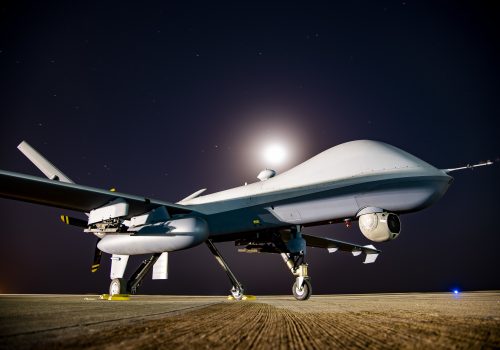The drones are small—the arms race may not be. Here’s how the US can win.
The era for small-drone warfare has arrived. Recent attacks on Israel and the continuing war in Ukraine have put a global spotlight on the proliferation of small, commercially available Unmanned Aerial Systems (sUAS), commonly known as drones. This proliferation of sUAS stands in stark contrast to the use of larger, more complex, and expensive military-grade UAVs, such as the MQ-9 Reaper, which remain out of reach for many militaries, rebel groups, and other non-state actors. These groups are instead embracing commercially available drones and transforming modern warfare and battlefield tactics as a result.
Russia and Ukraine have used drones to great effect on the battlefield. Now Russia is further developing Iranian designed “one-way” drones as an economically effective weapon. Leveraging the readily available technology, Ukraine has turned drones into tactical tools for reconnaissance, precision strikes, and the ongoing disruption of Russian forces.
Meanwhile in Yemen, Iran-backed Houthis have grown adept at using low-cost drones for attacks on Saudi infrastructure, international commercial shipping to disrupt global commerce, and, most recently, against Israel. In the Kurdistan region of Iraq and a small US outpost in Jordan, drones have been used to attack US and allied forces and punish their hosts.
Intercepted Iranian drones were broadcast across international media outlets following Tehran’s attack on Israel on April 14. Even before this, Israeli soldiers were being effectively attacked by Hamas’s deployment of drones outfitted with explosives and deployed to disrupt infrastructure and equipment such as cameras or to attack personnel.
Once viewed as mere toys, small drones have undergone a lightning-fast evolution into accessible, weaponized technology, disrupting the established international order. The deceptive simplicity of drone production and launch stands in stark contrast to the complexity of developing effective countermeasures and policies. Furthermore, past policies myopically focused on foreign trade or counterintelligence concerns, without considering the broader market, which is driving mass production.
How did this happen? In the early 2000s, drones arrived in two categories. The first were out of reach to most countries without advanced platform developers. The second and smaller category of drones was hobbled by limited flight times, speed, and range, as well as flaws in their basic functionality. However, over the last twenty years, advancements in battery technology, miniaturized electronics, sensor development, and artificial intelligence (AI)—as well as a proliferation of legitimate business use cases—have transformed the sUAS market. Drones have shed weight and size, extending flight times, and they have become enhanced by high-resolution cameras. Advanced features such as obstacle avoidance, GPS tracking, and AI integration are now commonplace. This breadth of accessibility sparked a boom in commercial and dual-use applications, bringing drones into everything from agriculture, delivery services, and filmmaking to search and rescue missions.
Countering the current threat while developing systems to address future evolutions is difficult. Recent attacks in Jordan and Israel show how easy and economical it is to deploy one-way “dumb” drones that have a simplistic flying mechanism with limited course correction capabilities. However, “smart” drones with more advanced capabilities are increasingly available, too. This includes lethal autonomous weapons systems that do not require data connectivity between the operator and the drone to attack targets. They’re known as “fire, forget, and find” platforms.
The situation becomes even more concerning when hundreds of sUAS could be deployed at once in swarms. Options to defend against such a barrage are currently limited. Layered air defense systems such as Israel’s Iron Dome, which employs a combination of radar, projectiles, and missiles to intercept all incoming threats from ballistic missiles to drones, are one option. Directed energy weapons are another, though they are in earlier stages of development and deployment.
In March, General Michael Kurilla, commander of US Central Command, described the problem facing US forces: “I would love to have the Navy produce more directed energy that can shoot down a drone, so I don’t have to use an expensive missile to shoot it down. But what’s worse than not having that expensive missile shoot it down is [the drone] hitting that two-billion-dollar ship with three hundred sailors on it.”
All of this raises a critical question: Could the United States effectively counter the continuous barrage of threats it faces given the global proliferation of this technology?
Despite the rapid evolution of drone technology over the last two decades, the United States military did not release its first Counter-Small Unmanned Aircraft Systems Strategy until 2021, and it’s vastly insufficient to address the new security challenges afoot. Other departments are standing up exploratory defensive efforts, such as the Department of Homeland Security’s Science and Technology Office, but a coherent all-of-government approach is lacking. The Department of Defense’s strategy currently emphasizes a defensive posture, or in other words, defeating adversarial drones once they’re airborne and on the attack. What does this mean in practice? US countermeasures are limited in their capacity to deter or dismantle the proliferation of smart bombs on the market. Regulation is difficult because the technology itself isn’t inherently dangerous—these drones are made up of a combination of readily available parts, including technologies often found in commercial items like hair dryers and Ring cameras.
From a tactical perspective, the technology used to neutralize small drones is underdeveloped. When used effectively, electronic warfare techniques can jam them and bring them down, but they do so at the cost of interfering with radios, cellphones, and every other related technology in the drone’s vicinity. Slower moving sUAS can be shot down but are often not relied on for a lethal attack. The Joint Counter-small Unmanned Aircraft Systems Office (JCO), stood up in 2020, is partnering with US Special Operations Command to finish an expanded counter-drone strategy. Their objective is to take the strategy beyond its current defense posture—“right of launch”—to disrupting enemy drones before they commence flight. As the US defense industrial base has astutely complained: Capacity is a challenge, so the United States cannot rely solely on counteracting threats with smart bombs of its own.
While the heightened focus on a new strategy is a welcome relief, there appears to be far less cross-collaboration planned across the rest of the government, the broader national security community, and other states. This will do little to deter or counter adversarial threats; the United States needs to overhaul its approach with a comprehensive counter-drone strategy. A national strategy would need to incentivize the market and create sustainable conditions for dual-use protection while not inhibiting the benefits of drone technology.
Such a strategy should have four guiding principles.
Reusable and more affordable solutions: The Office of the Secretary of Defense (OSD) Research and Engineering (R&E) should drive down the lifecycle cost of counter-drone measures by exploring and scaling production of reusable and more affordable technologies. R&E should partner with the Defense Advanced Research Projects Agency (DARPA) for advanced technology concepts and with the Joint Counter-Unmanned Aerial Systems Office (JCO) for rapid prototyping and fielding of mature solutions. This would reduce reliance on expensive single-use systems. JCO, in collaboration with defense contractors, should invest in the development of cheap drone hunters specifically designed to eliminate enemy drones. JCO can leverage its authorities for rapid acquisition and technology insertion to expedite the development and fielding of these drone hunters.
Sensor technology for cheaper drone hunters: The Department of Defense, through the JCO and OSD R&E, should request additional funding toward research and development in advanced sensor technology for both drone hunters and broader counter-drone systems. This includes exploring affordable sensors for early detection of enemy drones, as well as miniaturized sensors for equipping cost-effective drone hunters.
Multitiered approach to proliferation: While sanctions can target large commercially unavailable UAS platforms, a multi-pronged approach is needed to address the proliferation of smaller, more easily assembled drones due to their dual-use nature. Many of the components used in these drones have legitimate civilian applications, with parts widely available through online electronics stores, making them difficult to control through traditional export restrictions. The Department of State in collaboration with the Department of Commerce should develop more stringent and standardized export controls for drone components. These US departments should cooperate with allies and partners for a harmonized response and collaborate on joint research and development of counter-drone measures.
Multilayered defense: Develop and fund a comprehensive national counter-drone strategy that incorporates a multilayered defense system. This system should leverage:
- Early warning and detection: The Department of Defense should utilize advanced radar and sensor technology across the services to achieve early detection of drone threats.
- Kinetic countermeasures: JCO should plan for cost-effective kinetic countermeasures investment, such as reusable or attritable drone interceptors.
- Non-kinetic countermeasures: Through DARPA and military labs, the Department of Defense should develop advanced non-kinetic countermeasures that disrupt drone control signals and GPS navigation.
Matthew Rose is a nonresident senior fellow with the Atlantic Council’s GeoTech Center.
Kathryn Levantovscaia is a deputy director in the Forward Defense program of the Atlantic Council’s Scowcroft Center for Strategy and Security.
Further reading
Tue, Apr 2, 2024
Iranian drones have proliferated under US watch
IranSource By Daniel E. Mouton
Although the solution to stop the spread of Iranian drones is complex, it is important to note that there were plenty of warnings and time for the United States to prepare its defenses.
Tue, Feb 20, 2024
Outgunned Ukraine bets on drones as Russian invasion enters third year
UkraineAlert By
As Putin's invasion passes the two-year mark, tech-savvy Ukraine is betting on drones as the best way to overcome Russia's increasingly overwhelming advantage in traditional firepower, writes Mykola Bielieskov.
Thu, Nov 2, 2023
Autonomous weapons are the moral choice
New Atlanticist By Thomas X. Hammes
Arguments about whether democratic nations should field and employ lethal autonomous weapon systems miss the point. They have used autonomous weapons for decades.
Image: A small unmanned aircraft system (sUAS) is shown in flight at Dugway Proving Ground. The sUAS is one of three platforms utilized during a two-year study to locate golden eagle nests on the installation. The study was conducted to determine which platform worked best. Dugway Proving Ground photo.


